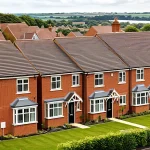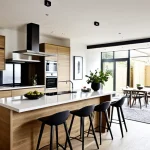Current Leading UK Modern Interior Design Trends
Understanding the modern home design trends in the UK for 2024 means recognizing how cultural and lifestyle shifts are shaping living spaces. The rise in remote working, increasing environmental awareness, and a desire for flexible yet cosy homes have dramatically influenced UK interior design choices. Homeowners now favor designs that balance aesthetics with practicality, reflecting both personality and evolving day-to-day needs.
Current UK interior trends show a strong preference for minimalist but warm designs. Clean lines coexist with natural elements, creating serene and inviting environments. Emphasis on sustainability has also pushed materials and furnishings toward eco-friendly options, integrating seamlessly into modern schemes. This trend underscores an important point: staying current with trade data and expert insights helps ensure designs are both stylish and forward-thinking.
Also read : How Can You Infuse Comfort and Style into Your UK Home Living Spaces?
Moreover, the demand for modular and multifunctional furniture is increasing to support diverse activities within the home. As UK lifestyles become more blended—combining work, relaxation, and socialising—the modern home must adapt accordingly. Keeping up with these modern home design trends ensures interiors remain relevant and livable in a rapidly changing world.
Popular Colour Palettes and Combinations
Colour plays a pivotal role in defining UK interior colour trends and shaping the atmosphere of modern homes. In 2024, several modern colour palettes dominate, reflecting a balance between bold expression and subtle sophistication. Earthy neutrals such as warm beiges, soft greys, and creamy whites continue to anchor many interiors, providing a timeless backdrop that enhances both light and space. These neutrals are often paired with accent tones drawn from nature—muted greens, terracotta, and deep blues—which add depth without overwhelming a room.
Additional reading : How Can UK Home Living Trends Change the Way We Design Our Spaces?
When considering trending colours UK homeowners and designers face an important choice: whether to embrace bold or neutral shades. Bold colours, such as rich emerald green, mustard yellow, and burnt orange, serve as statement accents on feature walls, cabinetry, or furnishings. They energize spaces and create focal points, especially in living rooms and kitchens. Conversely, neutral tones promote calmness and versatility, crucial for the multifunctional demands of modern homes. The strategic use of both bold and neutral colours allows for dynamic yet harmonious interiors, enabling adaptability in diverse UK living environments.
Recent design projects across the UK showcase these principles vividly. A popular approach involves layering textures and colours—for example, pairing a neutral taupe wall with velvet cushions in warm jewel tones or incorporating rattan accessories against a backdrop of soft greys. The contrast highlights the vibrancy of bold colours while grounding them in natural palettes. UK interiors increasingly favour these combinations to ensure spaces feel both contemporary and inviting, perfectly aligned with broader current UK interior trends.
Trending Materials and Textures
The rise of sustainable materials is a defining factor in contemporary UK interiors. Increasingly, designers and homeowners prioritise sustainable materials such as reclaimed wood, bamboo, and recycled metal to reduce environmental impact. These choices align with broader cultural shifts towards eco-conscious living, reinforcing the importance of materials that combine durability with ethical sourcing. The movement towards sustainability is not merely aesthetic but deeply integrated into contemporary materials UK interiors use, influencing every element from flooring to furniture.
In addition to sustainability, texture plays a crucial role in modern UK interiors. Popular home texture trends include tactile fabrics like boucle, velvet, and natural fibres such as rattan. Boucle is favoured for upholstery due to its soft, cozy appearance that adds warmth to minimalist spaces. Velvet cushions and throws introduce luxury and depth, particularly when paired with natural colours from the modern colour palettes. Rattan’s natural, woven texture brings an organic element indoors, enhancing spaces with subtle, tactile contrasts.
Designers often mix these textures to create layered, inviting environments. For example, a living room may combine a boucle sofa with velvet cushions and rattan accessories, balancing comfort and style while maintaining an eco-friendly ethos. This approach reflects the current trending materials focus on connecting visually and texturally with nature, delivering interiors that are both sustainable and sensorially rich. Notable UK projects increasingly showcase this synergy, demonstrating how contemporary materials UK interiors integrate sustainability without compromising sophistication.




